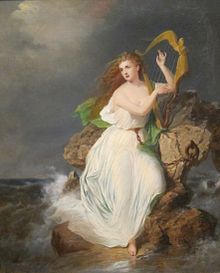Ériu

In Irish mythology, Ériu (Old Irish: [ˈeːrʲu]; modern Irish: Éire [ˈeːɾʲə] ⓘ), daughter of Delbáeth and Ernmas of the Tuatha Dé Danann, was the eponymous matron goddess of Ireland.
The English name for Ireland comes from the name Ériu and the Germanic (Old Norse or Old English) word land.
Since Ériu is represented as goddess of Ireland, she is often interpreted as a modern-day personification of Ireland, although since the name Ériu is the Old Irish form of the word Ireland, her modern name is often modified to Éire or Erin to suit a modern form.
Name and etymology
The name Ériu has been derived from reconstructed
Epithets
In the Banshenchas (a mediaeval text describing legendary and historical Irish women),[4] Ériu and her sisters are called:
- fair women of the Tuatha Dé Danand
- a famous throng
- clear voice of achievement
- three fair daughters of Fiachra
- bright women of spirited speech
Family
Different texts attribute differing personal relationships to Ériu. Ériu's sisters are consistently named as Banba and Fódla, who are members of the Tuatha Dé Danann, and the three sisters share a trio of brothers as husbands. In the
Role and mythical portrayal
With her sisters, Banba and Fódla, Ériu forms a triumvirate of goddesses. When the Milesians arrived from Galicia, each of the three sisters asked that her name be given to the country. This was granted to them, although Ériu (Éire) became the chief name in use.[6] (Banba and Fódla are still sometimes used as poetic names for Ireland, much as Albion is used as a poetic name for Great Britain.)
According to the 17th-century Irish historian Geoffrey Keating (Irish: Seathrún Céitinn), the three sovereignty goddesses associated with Éire, Banbha and Fódla were Badb, Macha and The Morrígan. Ériu, Banba and Fódla are also interpreted as goddesses of sovereignty.[9]
References
- ^ Mallory, J.P. and D.Q. Adams, ed. Encyclopedia of Indo-European Culture. London: Fitzroy Dearborn Pub., 1997, p. 194
- ^ a b c Koch, John T. (2005), Celtic Culture: A Historical Encyclopedia, ABC-CLIO, p.709
- ^ "Proto-Celtic—English lexicon" (PDF). Archived from the original (PDF) on 14 January 2006.
- ^ a b c d "Banshenchus". www.maryjones.us. Retrieved 3 January 2022.
- ^ Lebor Gabála Érenn. Online translation at www.ancienttexts.org
- ^ ISBN 9780486265070.
- ^ A. D. Rees; B. R. Rees (1961). "Celtic heritage : ancient tradition in Ireland and Wales". Thames and Hudson.
- ^ Revue celtique. Robarts - University of Toronto. Paris. 1870.
{{cite book}}: CS1 maint: others (link) - ^ Geoffrey Keating. "The History of Ireland". Foras Feasa ar Éirinn – via UCC.ie.
Bibliography
- Boydell, Barra. "The female harp: The Irish harp in 18th- and early–19th-century Romantic nationalism", RIdIM/RCMI newsletter XX/1 (spring 1995), 10–17.
